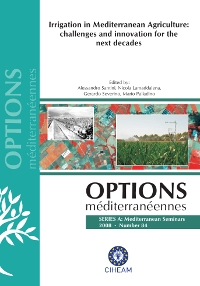| Article précédent | p. 177-184 | Article suivant |
Effects of deficit irrigation on two cherry tomato cultivars in hilly areas
In the last years the cultivation of cherry tomato significantly increased in the hilly areas of Campania region. Generally in the Campania hilly areas the species are cultivated under rainfed conditions to improve some quality parameters. The cultivation without irrigation is feasible thanks to the resistance to abiotic stress of cherry tomato and because climatic conditions of hilly areas of the region are characterized by erratic rainfall during the summer. The aim of the present work was to evaluate the response to deficit irrigation scheduling based on critical plant growth stages to ensure good productivity of two cultivars of cherry tomato (Altavilla cv. standard and Mignon hybrid). The trial was carried out in 2005 and 2006 at the experimental station of the CNR-ISAFoM, in Piano Cappelle (BN). The two cultivars were subjected to four irrigation regimes: T0 (rainfed), T1 (one irrigation at beginning of flowering), T2 (one irrigation at beginning of flowering and another at 50 percent of fruit set) and T3 (at beginning of flowering, at 50 percent of fruit setting and, after, every 15 days). Results showed that, in the area of the experiment, a limited water supply is useful to increase yield depending on the climate of the year and that it is possible to obtain high quality cherry tomatoes yield also with a limited irrigation water supply.
Depuis quelques années, la culture de la tomate cerise s'est remarquablement développée dans les zones collinaires de la Campanie où elle est cultivée sans irrigation afin d'en améliorer les paramètres qualitatifs. La culture sèche est réalisable grâce à la résistance de la tomate cerise au stress abiotique et aux conditions climatiques des collines de la région, caractérisées par des pluies estivales irrégulières. Le but de cette étude est d'évaluer la réponse de la plante à un schéma d'irrigation déficitaire se basant sur les stades critiques du développement de la plante pour assurer une bonne productivité de deux cultivars de tomate cerise (Altavilla cv. standard et Mignon hybrid). L'étude a été menée en 2005 et 2006 dans la station expérimentale du CNR-ISAFoM, située à Piano Cappelle (BN). Quatre régimes d'irrigation ont été administrés aux deux cultivars: T0 (sans irrigation), T1 (une irrigation en début de floraison), T2 (une irrigation en début de floraison et une autre à 50 pour cent de la nouaison) et T3 (en début de floraison, à 50 pour cent de la nouaison et, ensuite, tous les 15 jours). En fonction du climat de l'année dans la zone expérimentale, les résultats ont montré qu'un apport d'eau limité entraîne une augmentation de la production tout en permettant d'obtenir des tomates cerises de haute qualité.
- [ Afficher ]
- [ Télécharger ]
- [ Exporter la citation ]
Vous pouvez télécharger la citation au format :
- [ Imprimer ]
-
Mots-clés
DOSE D'IRRIGATION, REPONSE DE LA PLANTE, STADE DE DEVELOPPEMENT VEGETAL, TOMATE CERISECiter cet article
Pulvento C., Riccardi M., D'Andria R., Lavini A., Calandrelli D. Effects of deficit irrigation on two cherry tomato cultivars in hilly areas. In : Santini A. (ed.), Lamaddalena N. (ed.), Severino G. (ed.), Palladino M. (ed.). Irrigation in Mediterranean agriculture: challenges and innovation for the next decades. Bari : CIHEAM, 2008. p. 177-184. (Options Méditerranéennes : Série A. Séminaires Méditerranéens; n. 84). International Conference on Irrigation in Mediterranean Agriculture: Challenges and Innovation for the Next Decades, 2008/06/17-18, Naples (Italy). http://om.ciheam.org/om/pdf/a84/00800964.pdf



